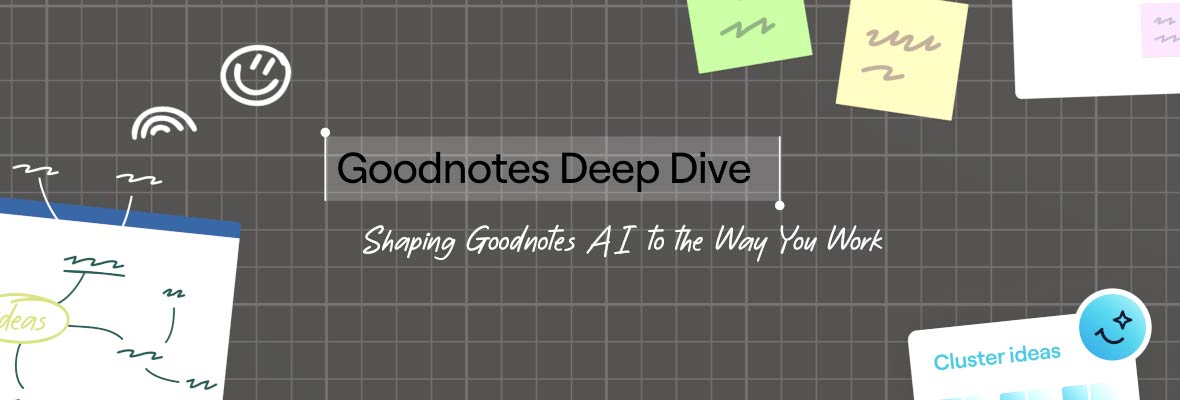As Goodnotes evolves, we’ve been studying how people actually work—the messy reality of capturing ideas, making connections, and shaping them into something meaningful. Understanding that is critical to ensuring that everything we build, particularly Goodnotes AI, helps you in ways that fit into your natural workflows.
Here's a peek inside our product development process for Goodnotes AI with product manager Xiu Ting and designer Leo. (For more on how we’re building a better Goodnotes for you, catch up on Designing AI as a True Collaborator and Building Whiteboard.)
Fitting into how you naturally work
Through ongoing user research with professionals, educators, and students, we saw a common pattern: start by seeking information, work to make sense of it, then share the resulting insights and ideas.
This is the seek–sense–share cycle, and we decided to design Goodnotes AI to amplify this type of intuitive workflow. After all, we know AI is only truly helpful when integrated thoughtfully into how you actually work.
Tackling blank page syndrome
Getting started is often the hardest part of any task. Many of you already use templates in Goodnotes to overcome that “where do I start?” paralysis. But it’s not always easy finding the right template for your specific task and context.
To make sure you never have to struggle with a blank page again, our first area of focus was to ensure Goodnotes AI can get you from 0→1. In this case, that means generating custom templates based on your specific needs—whether you’re hosting a brainstorm on a Whiteboard or prepping to take notes in a sales call.
The key is context: Goodnotes AI understands not just what you're asking for, but where you're working and what's already there.
Help right where you need it
User feedback made it clear that as you're reviewing, synthesizing, and building on your notes, you need AI that’s able to work right alongside you—but never get in the way.
To find just the right balance, we started by building three different ways for you to choose from as you work with Goodnotes AI:
- Floating: The Goodnotes AI interface stays minimal and movable, perfect for quick questions or edits while without covering your document.
- Sidebar: When you prefer to see conversation history or work through more complex tasks, the sidebar keeps everything organized while your notes stay fully visible.
- Window: For deeper work with Goodnotes AI, when you want to be focused on your collaborative discussion and iteration with it, you can switch to a window view.
And also in the works is a better way to prompt Goodnotes AI with the Lasso tool, letting you simply circle what you want the AI to focus on or draw context from.
Seamless, but not invisible
We understood from users that AI should both feel natural in your workflow and also be transparent about what it's doing.
Some examples of how we’re putting this principle in practice:
- You always have the option to preview and modify any changes by Goodnotes AI before inserting them in your document.
- Goodnotes AI shows you exactly what steps it took to complete each task, helping you build understanding and confidence in its work.
- As just one example of how we’re crafting Goodnotes AI’s input to feel at home in your documents, we’ve designed a dedicated color system for its contributions to harmonize with your work.
- We’re continuing to experiment with how Goodnotes AI might show what it’s thinking and doing, such as through cursor labels and animations. (This is still very much a work in progress, and we’d love your input!)
Features like these are designed to enable you to always know what Goodnotes AI is doing and maintain control over the results, even as the interaction feels effortless.
Help shape the future of Goodnotes AI
Whether during the beta and beyond, it’s your real-world usage and needs that shape every feature we build.
We can’t wait to see what you do with Goodnotes AI and hear how we can make it even better for how you seek, sense, and share!
